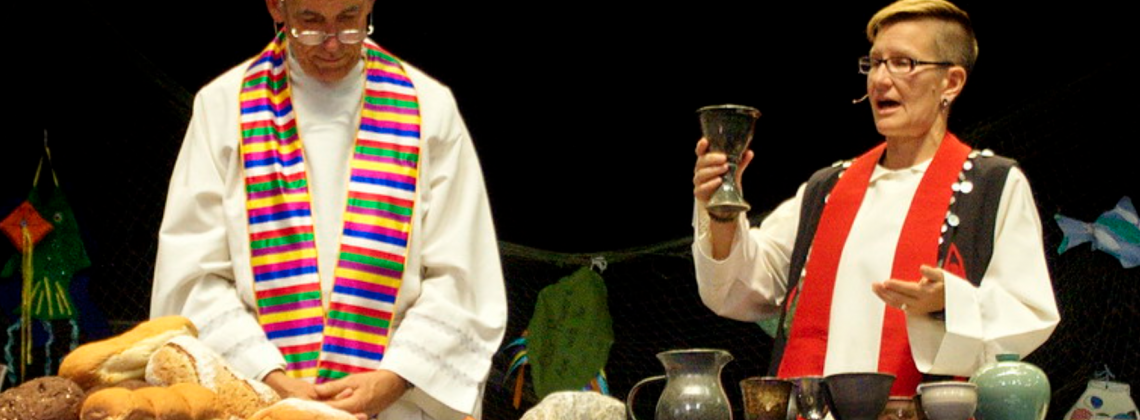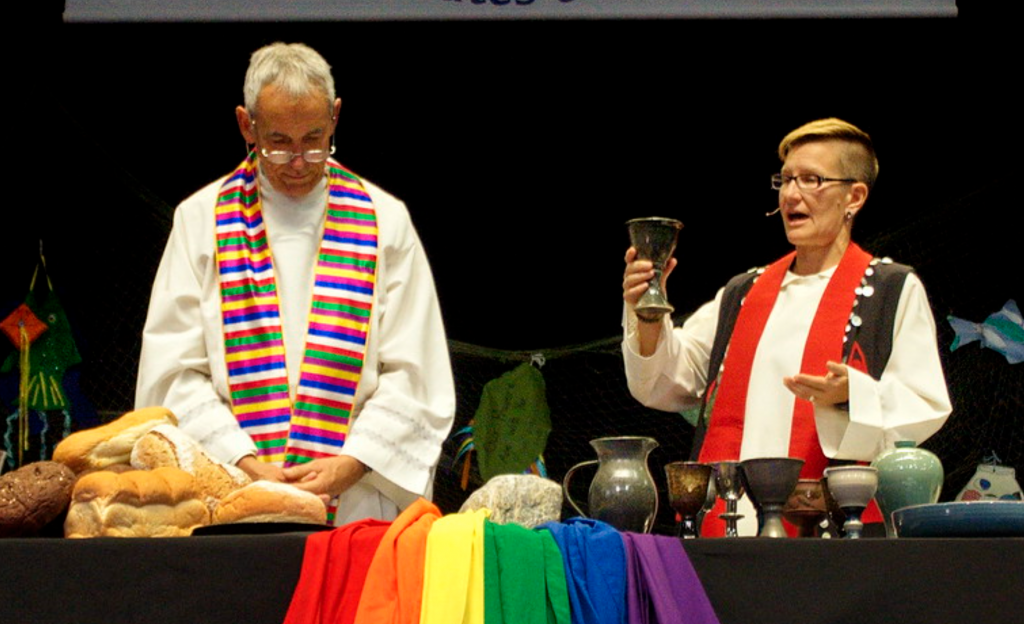

The divide exists—and so do unexpected forms of mutual influence
Why does the prevailing story of evangelical Protestantism’s rise to prominence say so little about evangelicalism’s dialectical relationship with mainline, ecumenical Protestantism?
Why have ecumenical critics of evangelicalism, amid their vocal concerns about racism, sexism, homophobia, and Christian Nationalism, failed to challenge evangelicals more directly about biblical hermeneutics?
These two uncertainties have troubled me for some time. They are among the several questions I address in Christianity’s American Fate: How Religion Became More Conservative and Society More Secular (Princeton, 2022). In commenting on these two questions, I will draw from the book.
First, to the tendency of both journalistic and scholarly writers to explain evangelicalism’s ascendance in something of a religious vacuum. Much is made of the machinations of the Republican Party and of conservative corporate magnates—but not so much of the distinctly religious context of evangelicalism’s growth in size and public authority. This is all the more striking in view of a long understood truth about the fundamentalist movement of the 1910s and 1920s. That movement was, in George M. Marsden’s classic formulation, “a federation of co-belligerents united by their fierce opposition to modernist attempts to bring Christianity into line with modern thought.”
The various Protestants who began to call themselves “evangelicals” during the 1940s achieved substantial institutional coherence through the National Association of Evangelicals (1942), Fuller Theological Seminary (1947), and Christianity Today (1956). But crucially, this coherence was achieved by responding to the initiatives of the rival, ecumenical, mainline leadership. The dynamic was not so different from the earlier modernist-fundamentalist episode.
The mainline, ecumenical leadership carried out a campaign for a more cosmopolitan Protestantism. This campaign should be prominent in our narratives of modern American religious history, but demonstrably is not. It took shape around several clusters of issues. One was international: During and immediately after World War II ecumenical leaders came on strong for global cooperation, lobbying vigorously for the United Nations and for human rights protections. Another was white supremacy: By 1946, several ecumenical-dominated organizations, including the Federal Council of Churches, Church Women United, the YMCA, the YWCA, and the social justice agencies of the Congregationalists and Methodists supported African American demands for equal treatment. On economic issues many of the mainline leaders defended government regulation of business, and some spoke casually about the possibility of getting beyond private property. Harry Emerson Fosdick and Ralph Sockman preached theological liberalism to national radio audiences. Sex education in public schools was advocated by liberal Protestants throughout the country.
None of these initiatives played well with the people who in the second half of the twentieth century developed the media networks, private schools, trans-denominational organizations, and other institutions that steadily increased the evangelical role in American public life. But while the triumphs of evangelicalism are widely recognized, this story is often told with minimal attention to the prior agency of the ecumenical intelligentsia. Even the new, 2019 edition of Mark Noll’s comprehensive textbook, A History of Christianity in the United States and Canada, which provides an excellent account of evangelicalism’s importance, says little about the dynamics of the ecumenical-evangelical divide. The same is true of James P. Byrd and James Hudnut-Beumler’s new The Story of Religion in America: An Introduction.
While working on Christianity’s American Fate, I was struck by how many voices I found echoing the argument made fifty years ago by Dean M. Kelley, an official of the ecumenical National Council of Churches. Kelley’s Why Conservative Churches are Growing: A Study in the Sociology of Religion held that evangelical churches were growing because they demanded something from the faithful, while ecumenical churches were not growing because they did not demand much of anything. The opposite is true: Evangelicalism provided a safe harbor for white Americans who wanted to be counted as Christians while avoiding the challenges of an ethnoracially diverse society and a scientifically informed culture. Demanding that the faithful meet these challenges was central to the campaign for a more cosmopolitan Protestantism. Evangelicalism achieved definition on terms presented by ecumenical leaders, moving them in the opposite direction.
My second troubling question is why the ecumenical intelligentsia failed to mount a more direct and sustained public challenge to evangelical ideas about the Bible. The mainline intellectuals expended much energy criticizing the racism, sexism, homophobia, and theocratic tendencies of evangelicals, but they devoted remarkably little attention to biblical hermeneutics. Yes, there were plenty of refutations of Paul’s strictures against women speaking in church, and copious commentaries on the apostle’s utterances about sex. Galatians 3:28 was cited routinely in support of a greater egalitarianism than the ecumenical speakers ascribed to the culture of evangelicalism. But I found remarkably little of the spirit of Fosdick’s legendary 1922 manifesto, “Must the Fundamentalists Win?” Why, I kept wondering, did so few of the ecumenical intellectuals tear into evangelical claims about the Bible, tout court, and make the religion writers for the national press pay attention? I found ecumenical intellectuals more interested in exposing the limitations of the New Atheists than in criticizing evangelical ideas about scripture. Why were historically sophisticated perspectives like those of L. Harold DeWolf usually kept in the discourse of the seminaries, and not proclaimed loudly and widely? DeWolf scoffed at the doctrine of the atonement as a holdover from the ancient practice of blood sacrifice, “at best a quaint and alien figure of speech,” yet remarkably few ecumenical preachers were willing to say such things from the pulpit or in interviews with the religion writers of the national press.
Episcopal bishop Shelby Spong was of course a prominent exception to this relative silence, and there were other exceptions, too. But as I explored this issue personally with quite a few individuals who teach in today’s liberal seminaries or are otherwise embedded in ecumenical circles, I found very little pushback to my somewhat querulous assertion that the ecumenical elite had chosen not to plant its flag in the Bible. This elite had, by and large, allowed the symbolic capital of Christianity to fall increasingly into the hands of evangelicals, to whom the Bible belonged more than ever. Yes, there was plenty of sophisticated biblical interpretation in the divinity schools. Hans Frei? Schubert Ogden? Of course. But readers of the New York Times and Washington Post and the Atlantic and the Guardian could get the impression that the ecumenical-evangelical divide was mostly about race, gender, and same-sex relationships, and, more recently, about “Christian nationalism,” instead of a more fundamental division about the nature of scripture itself.
Anyone can argue about race, gender, sex, and nationalism, but the ecumenical leadership, trained in the study of the Bible, said remarkably little about issues on which they might have spoken with unique authority and sophistication: what the Bible actually was, how it was best read, and what guidance it offered—and did not offer—for conduct in today’s world. Why this relative silence? I am not sure. My book does not offer a confident answer. I do suggest that avoiding these issues was a way to keep peace within the community of faith. And I add that there seems to have been some anxiety that the people in the pews might leave the churches if they found out what the preacher really thought about the epistemic status of scripture.
I remember from own high school days as president of my church’s Youth Fellowship how members of our church board refused to accept the minister’s patient insistence that it did not really matter whether or not Jesus was the product of a virgin birth. As a reader of motive, I was fine with this liberal claim, but a number of the older parishioners even in our ecumenical congregation of the Church of the Brethren continued to believe that the faith’s integrity depended on such notions as the virgin birth. Bultmann? Kerygma and Myth? Preachers who tried that sort of thing did not always fare well. Perhaps that’s why the fighting spirit of Fosdick was not seen more often. I won’t begin here to discuss what costs there might have been to this relative passivity. Langdon Gilkey once spoke of it as “a conspiracy of silence.” But as with the first question, discussed above, I hope my book will generate more discussion of the character and significance of the ecumenical-evangelical divide.
David A. Hollinger is Preston Hotchkis Professor of History Emeritus at the University of California, Berkeley. He is a former President of the Organization of American Historians and an elected member of the American Academy of Arts and Sciences and of the American Philosophical Society.
Many thanks, Dr Hollinger. My understanding is that mainline churches are much less effective at retaining as active members the children raised in their churches when they become adults than are evangelical churches. Is that correct? If not, it would be helpful work to refute that notion. If it is correct, however, than I think figuring out why it is so would be a crucial key to this project and line of investigation.
During my first year in seminary (at age 31) I was surprised to find out that 100 year-old biblical scholarship had not filtered down to people in the pew. And like Dr. Hollanger I wondered why. And when we left an evangelical church to join a mainline church I thought that biblical scholarship had reached the “liberals.” But it had not. My conclusion is that ministers of regular chucrh-going Christians are afraid to get into fusses over the Bible. Evangelical pastors believe that biblical criticism leads to unbelief and will preach against it in general. Mainline pastors just keep it in the background with little hints maybe here and there. Leading the flock is most important, not stirring up the troops about how the Bible may not be what you think it is. But I think times are changing. We will see.